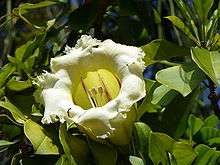Solandra grandiflora
Solandra grandiflora, the showy chalicevine, or papaturra[1] is a member of the nightshade ( Solanaceae ) genus Solandra and, like the other members of the genus, is a climbing plant with large, attractive, trumpet-shaped flowers. It is native to Central America and northern South America and is widely grown in the tropics as an ornamental.[2] The green parts of the plant are highly toxic (hallucinogenic / delirient in small doses), due to tropane alkaloid content,[3] and have caused deaths from anticholinergic poisoning,[4] but the flesh of the ripe fruit ( although not the unripe fruit or seeds ) is said to be edible. The fruits, which are globular and largely enclosed by the accrescent calyces, can reach a kilogram in weight and have a taste described as apple-like or melon-like.[2]
| Solandra grandiflora | |
|---|---|
 | |
| Scientific classification | |
| Kingdom: | Plantae |
| Clade: | Tracheophytes |
| Clade: | Angiosperms |
| Clade: | Eudicots |
| Clade: | Asterids |
| Order: | Solanales |
| Family: | Solanaceae |
| Genus: | Solandra |
| Species: | S. grandiflora |
| Binomial name | |
| Solandra grandiflora Sw. | |
Symptoms of poisoning
Symptoms caused by ingestion of plant parts - even from chewing fragments of flowers - include dryness of throat, headache, weakness, fever, delirium, hallucinations and potentially fatal circulatory and respiratory failure.[5]
Gallery
 Side view of white-flowered form, showing trumpet shape of corolla.
Side view of white-flowered form, showing trumpet shape of corolla._001.jpg) Fruit, showing accrescent calyx. Vernacular name in Central America Papaturra.
Fruit, showing accrescent calyx. Vernacular name in Central America Papaturra.
References
- "Solandra grandiflora". Natural Resources Conservation Service PLANTS Database. USDA. Retrieved 16 November 2015.
- Lötschert, W. & Beese, G. ( translated by Clive King ) 1994 Collins Photo Guide to Tropical Plants pub. Harper Collins. ISBN 0 00 219112 1. Page 51.
- https://wiki.tripsit.me/wiki/Cup_of_Gold Retrieved at 11.48am on 17/5/19
- Quattrocchi, Umberto (2012). CRC World dictionary of medicinal and poisonous plants: common names, scientific names, eponyms, synonyms and etymology, pub. CRC Press Taylor and Francis Group. Vol. V: R-Z pps. 308-9.
- Tampion, John 1977, Dangerous Plants pub. David and Charles ISBN 0 7153 7375 7. Page 28 - heading: Solandra guttata.